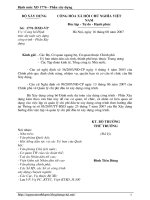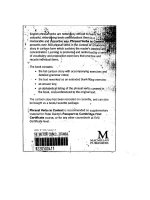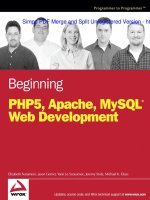0321210255 split 1 6276
Bạn đang xem bản rút gọn của tài liệu. Xem và tải ngay bản đầy đủ của tài liệu tại đây (3 MB, 7 trang )
Simpo PDF Merge and Split Unregistered Version -
d ata b a s e
systems
Both Thomas Connolly and Carolyn Begg have
experience of database design in industry, and now
apply this in their teaching and research at the
University of Paisley in Scotland.
A Practical Approach to Design,
Implementation, and Management
•
Begg
A clear introduction to design, implementation and management issues, as well as an extensive
treatment of database languages and standards, make this book an indispensable complete
reference for database students and professionals alike
Features
Complex subjects are clearly explained using running case studies throughout the book.
Database design methodology is explicitly divided into three phases: conceptual, logical, and
physical. Each phase is described with an example of how it works in practice.
SQL is comprehensively covered in three tutorial-style chapters.
Distributed, object-oriented, and object-relational DBMSs are fully discussed.
Check out the Web site at www.booksites.net/connbegg, for full implementations of the case
studies, lab guides for Access and Oracle, and additional student support.
New! For the fourth edition
•
•
•
Extended treatment of XML, OLAP and data mining.
Coverage of updated standards including SQL:2003, W3C (XPath andXQuery), and OMG.
Now covers Oracle9i and Microsoft Office Access 2003.
This book comes with a free six-month subscription to Database Place, an online
tutorial that helps readers master the key concepts of database systems.
Log on at www.aw.com/databaseplace.
FOURTH
EDITION
d ata b a s e
systems
Over 200,000 people have been grounded in good database design practice by reading Database
Systems. The new edition of this best-seller brings it up to date with the latest developments in
database technology and builds on the clear, accessible approach that has contributed to the success
of previous editions.
an imprint of
www.booksites.net/connbegg
Connolly
FOURTH EDITION
•
•
•
•
•
•
Thomas Connolly Carolyn Begg
d ata b a s e
systems
A Practical Approach to Design,
Implementation, and Management
www.booksites.net/connbegg
www.booksites.net/connbegg
www.pearson-books.com
Simpo PDF Merge and Split Unregistered Version -
Databa se
Systems
A Companion Web site accompanies Database Systems,
Fourth edition by Thomas Connolly and Carolyn Begg
Visit the Database Systems Companion Web site at www.booksites.net/connbegg
to find valuable learning material including:
For Students:
n
n
n
n
n
n
Tutorials on selected chapters
Sample StayHome database
Solutions to review questions
DreamHome web implementation
Extended version of File Organizations and Indexes
Access and Oracle Lab Manuals
Simpo PDF Merge and Split Unregistered Version -
INTERNATIONAL COMPUTER SCIENCE SERIES
Consulting Editor A D McGettrick University of Strathclyde
SELECTED TITLES IN THE SERIES
Operating Systems J Bacon and T Harris
Programming Language Essentials H E Bal and D Grune
Programming in Ada 95 (2nd edn) J G P Barnes
Java Gently (3rd edn) J Bishop
Software Design (2nd edn) D Budgen
Concurrent Programming A Burns and G Davies
Real-Time Systems and Programming Languages: Ada 95, Real-Time Java and RealTime POSIX (3rd edn) A Burns and A Wellings
Comparative Programming Languages (3rd edn) L B Wilson and R G Clark, updated by
R G Clark
Distributed Systems: Concepts and Design (3rd edn) G Coulouris, J Dollimore and T
Kindberg
Principles of Object-Oriented Software Development (2nd edn) A Eliëns
Fortran 90 Programming T M R Ellis, I R Philips and T M Lahey
Program Verification N Francez
Introduction to Programming using SML M Hansen and H Rischel
Functional C P Hartel and H Muller
Algorithms and Data Structures: Design, Correctness, Analysis (2nd edn) J Kingston
Introductory Logic and Sets for Computer Scientists N Nissanke
Human–Computer Interaction J Preece et al.
Algorithms: A Functional Programming Approach F Rabhi and G Lapalme
Ada 95 From the Beginning (3rd edn) J Skansholm
C++ From the Beginning J Skansholm
Java From the Beginning (2nd edn) J Skansholm
Software Engineering (6th edn) I Sommerville
Object-Oriented Programming in Eiffel (2nd edn) P Thomas and R Weedon
Miranda: The Craft of Functional Programming S Thompson
Haskell: The Craft of Functional Programming (2nd edn) S Thompson
Discrete Mathematics for Computer Scientists (2nd edn) J K Truss
Compiler Design R Wilhelm and D Maurer
Discover Delphi: Programming Principles Explained S Williams and S Walmsley
Software Engineering with B J B Wordsworth
Simpo PDF Merge and Split Unregistered Version -
THOMAS M. CONNOLLY
• CAROLYN E. BEGG
UNIVERSITY OF PAISLEY
Databa se
Systems
A Practical Approach to Design,
Implementation, and Management
Fourth Edition
Simpo PDF Merge and Split Unregistered Version -
Pearson Education Limited
Edinburgh Gate
Harlow
Essex CM20 2JE
England
and Associated Companies throughout the world
Visit us on the World Wide Web at:
www.pearsoned.co.uk
First published 1995
Second edition 1998
Third edition 2002
Fourth edition published 2005
© Pearson Education Limited 1995, 2005
The rights of Thomas M. Connolly and Carolyn E. Begg to be identified as
authors of this work have been asserted by the authors in accordance with the
Copyright, Designs and Patents Act 1988.
All rights reserved. No part of this publication may be reproduced, stored in a
retrieval system, or transmitted in any form or by any means, electronic,
mechanical, photocopying, recording or otherwise, without either the prior written
permission of the publisher or a licence permitting restricted copying in the United
Kingdom issued by the Copyright Licensing Agency Ltd, 90 Tottenham Court
Road, London W1T 4LP.
The programs in this book have been included for their instructional value. They
have been tested with care but are not guaranteed for any particular purpose. The
publisher does not offer any warranties or representations nor does it accept any
liabilities with respect to the programs.
All trademarks used herein are the property of their respective owners.
The use of any trademark in this text does not vest in the author or publisher
any trademark ownership rights in such trademarks, nor does the use of such
trademarks imply any affiliation with or endorsement of this book by such owners.
ISBN 0 321 21025 5
British Library Cataloguing-in-Publication Data
A catalogue record for this book is available from the British Library
Library of Congress Cataloguing-in-Publication Data
A catalog record for this book is available from the Library of Congress
10 9 8 7 6 5 4 3 2
09 08 07 06 05
Typeset in 10/12pt Times by 35
Printed and bound in the United States of America
628
|
Chapter 20 z Transaction Management
Simpo PDF Merge and Split Unregistered Version -
Exercises
20.17 Analyze the DBMSs that you are currently using. What concurrency control protocol does each DBMS use?
What type of recovery mechanism is used? What support is provided for the advanced transaction models
discussed in Section 20.4?
20.18 For each of the following schedules, state whether the schedule is serializable, conflict serializable, view
serializable, recoverable, and whether it avoids cascading aborts:
(a) read(T1, balx ), read(T2, balx ), write(T1, balx ), write(T2, balx ), commit(T1), commit(T2)
(b) read(T1, balx ), read(T2, baly), write(T3, balx ), read(T2, balx ), read(T1, baly), commit(T1), commit(T2),
commit(T3)
(c) read(T1, balx ), write(T2, balx ), write(T1, balx ), abort(T2), commit(T1)
(d) write(T1, balx ), read(T2, balx ), write(T1, balx ), commit(T2), abort(T1)
(e) read(T1, balx ), write(T2, balx ), write(T1, balx ), read(T3, balx ), commit(T1), commit(T2), commit(T3)
20.19 Draw a precedence graph for each of the schedules (a) to (e) in the previous exercise.
20.20 (a) Explain what is meant by the constrained write rule and explain how to test whether a schedule is
conflict serializable under the constrained write rule. Using the above method, determine whether the
following schedule is serializable:
S = [R1(Z), R2(Y), W2(Y), R3(Y), R1(X), W1(X), W1(Z), W3(Y), R2(X), R1(Y), W1(Y), W2(X),
R3(W), W3(W)]
where Ri (Z)/Wi (Z) indicates a read/write by transaction i on data item Z.
(b) Would it be sensible to produce a concurrency control algorithm based on serializability? Justify your
answer. How is serializability used in standard concurrency control algorithms?
20.21 (a) Discuss how you would test for view serializability using a labeled precedence graph.
(b) Using the above method, determine whether the following schedules are conflict serializable:
(i)
(ii)
(iii)
S1 = [R1( X ), W2( X ), W1( X )]
S2 = [W1( X ), R2( X ), W3( X ), W2( X )]
S3 = [W1( X ), R2( X ), R3( X ), W3( X ), W4( X ), W2( X )]
20.22 Produce a wait-for graph for the following transaction scenario, and determine whether deadlock exists:
Transaction
Data items locked
by transaction
Data items transaction
is waiting for
T1
T2
T3
T4
T5
T6
T7
x2
x3, x10
x8
x7
x1, x5
x4, x9
x6
x1, x3
x7, x8
x4, x5
x1
x3
x6
x5
20.23 Write an algorithm for shared and exclusive locking. How does granularity affect this algorithm?
20.24 Write an algorithm that checks whether the concurrently executing transactions are in deadlock.
Exercises
|
629
Simpo PDF Merge and Split Unregistered Version -
20.25 Using the sample transactions given in Examples 20.1, 20.2, and 20.3, show how timestamping could be used
to produce serializable schedules.
20.26 Figure 20.22 gives a Venn diagram showing the relationships between conflict serializability, view serializability, two-phase locking, and timestamping. Extend the diagram to include optimistic and multiversion
concurrency control. Further extend the diagram to differentiate between 2PL and strict 2PL, timestamping
without Thomas’s write rule, and timestamping with Thomas’s write rule.
20.27 Explain why stable storage cannot really be implemented. How would you simulate stable storage?
20.28 Would it be realistic for a DBMS to dynamically maintain a wait-for graph rather than create it each time the
deadlock detection algorithm runs? Explain your answer.









